Study on the Lamb Meat Consumer Behavior in Brazil
Abstract
:1. Introduction
- Q1.
- Whether the purchase or consumption habits of food in general or lamb meat depend on whether the consumer lives in a rural or urban area.
- Q2.
- Whether the purchase or consumption habits of food in general or the perception of lamb meat quality depend on the region of the country where the consumer lives.
- Q3.
- Whether sociodemographic variables (age, gender, schooling, and income) affect the purchase or consumption habits in general or of lamb meat.
- Q4.
- Whether the consumption habits or perception of lamb meat quality are related to the frequency of lamb meat consumption.
- Q5.
- Whether the groups of consumers that will consume lamb meat can be predicted and consumer profiles identified.
2. Materials and Methods
3. Results and Discussion
3.1. Influence of the Place of Residence
3.2. The Regionality Factor
3.3. Consumer Habits and Sociodemographic Characterization
3.4. Food-Consumption Habits and Perception of Lamb Meat Quality in Relation to the Frequency of Consumption
3.5. Lamb Meat Consumption Groups and Consumer Clustering
4. Conclusions
Author Contributions
Funding
Institutional Review Board Statement
Informed Consent Statement
Acknowledgments
Conflicts of Interest
References
- Fowler, S.M.; Morris, S.; Hopkins, D.L. Nutritional composition of lamb retail cuts from the carcases of extensively finished lambs. Meat Sci. 2019, 154, 126–132. [Google Scholar] [CrossRef]
- Suleman, R.; Wang, Z.; Aadil, R.M.; Hui, T.; Hopkins, D.L.; Zhang, D. Effect of cooking on the nutritive quality, sensory properties and safety of lamb meat: Current challenges and future prospects. Meat Sci. 2020, 167, 108172. [Google Scholar]
- Magalhães, K.A. Ovinocultura e Caprinocultura: Conjuntura econômica, Aspectos Produtivos de 2017 e Perspectivas Para 2018; Embrapa Caprinos e Ovinos: Sobral, Brasil, 2018; p. 23. [Google Scholar]
- Embrapa. Available online: https://ainfo.cnptia.embrapa.br/digital/bitstream/item/202196/1/CNPC-2019-Boletim-CI-n8.pdf (accessed on 16 April 2021).
- Andrade, J.C.; Sobral, L.A.; Ares, G.; Deliza, R. Understanding consumers’ perception of lamb meat using free word association. Meat Sci. 2016, 117, 68–74. [Google Scholar] [CrossRef]
- Ripoll, G.; Joy, M.; Panea, B. Consumer Perception of the Quality of Lamb and Lamb Confit. Foods 2018, 7, 80. [Google Scholar] [CrossRef] [PubMed] [Green Version]
- Borgogono, M.; Favotto, S.; Corazzin, M.; Cardello, A.V.; Piasentier, E. The role of product familiarity and consumer involvement on linking and perceptions of fresh meat. Food Qual. Prefer. 2015, 44, 1347–1391. [Google Scholar]
- Font-i-Furnols, M.; Guerrero, L. Consumer preference, behavior and perception about meat and meat products: An overview. Meat Sci. 2014, 98, 361–371. [Google Scholar] [CrossRef]
- Onwezen, M.C.; Reinders, M.J.; Van der Lans, I.A.; Sijtsema, S.J.; Jasiulewicz, A.; Guardia, M.D.; Guerrero, L. A cross-national consumer segmentation based on food benefits: The link with consumption situations and food perceptions. Food Qual. Prefer. 2012, 24, 276–286. [Google Scholar] [CrossRef]
- Chrysochou, P.; Askegaard, S.; Grunert, K.G.; Kristensen, D.B. Social discourses of healthy eating. A market segmentation approach. Appetite 2010, 55, 288–297. [Google Scholar] [CrossRef]
- Piqueras-Fiszman, B.; Jaeger, S.R. Consumer segmentation as a means to investigate emotional associations to meals. Appetite 2016, 105, 249–258. [Google Scholar] [CrossRef]
- Buckley, M.; Cowan, C.; McCarthy, M. The convenience food market in Great Britain: Convenience food lifestyle (CFL) segments. Appetite 2007, 49, 600–617. [Google Scholar] [CrossRef]
- Gil, J.M.; Gracia, A.; Sanchez, M. Market segmentation and willingness to pay for organic products in Spain. Int. Food Agribus. Manag. Rev. 2000, 3, 207–226. [Google Scholar] [CrossRef]
- Larsson, C.L.; Klock, K.S.; Nordrehaug Åstrøm, A.; Haugejorden, O.; Johansson, G. Lifestyle-related characteristics of young low-meat consumers and omnivores in Sweden and Norway. J. Adolesc. Health 2002, 31, 1898–1901. [Google Scholar] [CrossRef]
- Bernués, A.; Olaizola, A.; Corcoran, K. Extrinsic attributes of red meat as indicators of quality in Europe: An application for market segmentation. Food Qual. Prefer. 2003, 14, 265–276. [Google Scholar] [CrossRef]
- Zakowska-Biemans, S. Beef consumer segment profiles based on information source usage in Poland. Meat Sci. 2017, 124, 105–113. [Google Scholar] [CrossRef] [PubMed]
- Ripoll, G.; Alberti, P.; Panea, B. Consumer Segmentation Based on Food-Related Lifestyles and Perception of Chicken Breast. Int. J. Poult. Sci. 2015, 14, 262–275. [Google Scholar] [CrossRef] [Green Version]
- Realini, C.E.; Kallas, Z.; Juan, M.P.; Gómez, I. Relative importance of cues underlying Spanish consumers’ beef choice and segmentation, and consumer liking of beef enriched with n-3 and CLA fatty acids. Food Qual. Prefer. 2014, 33, 74–85. [Google Scholar] [CrossRef]
- Panella-Riera, N.; Blanch, M.; Kallas, Z.; Chevillon, P. Consumers’ segmentation based on the acceptability of meat from entire male pigs with different boar taint levels in four European countries: France, Italy, Spain and United Kingdom. Meat Sci. 2016, 114, 137–145. [Google Scholar] [CrossRef] [PubMed] [Green Version]
- Barone, B.; Nogueira, R.M.; Guimarães, K.R.L.S.L.d.Q.; Behrens, J.H. Sustainable diet from the urban Brazilian consumer perspective. Food Res. Int. 2019, 124, 206–212. [Google Scholar] [CrossRef] [PubMed]
- Quevedo-Silva, F.; Lima-Filho, D.O.; Fagundes, M.B.B. Dimensions of food choice process of older consumers in Brazil. Br. Food J. 2018, 120, 984–998. [Google Scholar] [CrossRef]
- Missagia, S.V.; Oliveira, S.R.; Rezende, D. Motivations related to food choice: Consumer segmentation. Agroalimentaria 2017, 23, 107–121. [Google Scholar]
- Gaze, L.V.; Oliveira, B.R.; Ferrao, L.L.; Granato, D.; Cavalcanti, R.N.; Conte Júnior, C.A.; Cruz, A.G.; Freitas, M.Q. Preference mapping of dulce de leche commercialized in Brazilian markets. J. Dairy Sci. 2015, 98, 1443–1454. [Google Scholar] [CrossRef]
- Araújo, F.F.; Rocha, A.; Chauvel, M.A.; Schulze, M. Meanings of leisure among young consumers of a Rio de Janeiro low-income community. Leis. Stud. 2013, 32, 319–332. [Google Scholar] [CrossRef]
- Bernués, A.; Ripoll, G.; Panea, B. Consumer segmentation based on convenience orientation and attitudes towards quality attributes of lamb meat. Food Qual. Prefer. 2012, 26, 211–220. [Google Scholar] [CrossRef]
- Ripoll, G.; Panea, B. The Effect of Consumer Involvement in Light Lamb Meat on Behavior, Sensory Perception, and Health-Related Concerns. Nutrients 2019, 11, 1200. [Google Scholar] [CrossRef] [PubMed] [Green Version]
- Brunsø, K.; Grunert, K.G. Development and testing of a cross-culturally valid instrument: Food-related life style. Adv. Consum. Res. 1995, 22, 475–480. [Google Scholar]
- Krystallis, A.; Chryssochoidis, G.; Scholderer, J. Consumer-perceived quality in ‘traditional’ food chains: The case of the Greek meat supply chain. Appetite 2007, 48, 54–68. [Google Scholar] [CrossRef]
- Instituto Brasileiro de Geografia e Estatística. Available online: https://www.ibge.gov.br/estatisticas/sociais/populacao/9171-pesquisa-nacional-por-amostra-de-domicilios-continua-mensal.html?=&t=destaques (accessed on 16 June 2021).
- Escofier, B.; Pagès, J. Análisis Factoriales Simples y Múltiples-Objetivos, Métodos e Interpretación; Universidad del Pais Vasco: Bilbao, Spain, 1992; p. 285. [Google Scholar]
- Acebrón, L.B.; Dopico, D.C. The importance of intrinsic and extrinsic cues to expected and experienced quality: An empirical application for beef. Food Qual. Prefer. 2000, 11, 2238–2292. [Google Scholar]
- Forestell, C.A.; Spaeth, A.M.; Kane, S.A. To eat or not to eat red meat. A closer look at the relationship between restrained eating and vegetarianism in college females. Appetite 2012, 58, 3193–3225. [Google Scholar] [CrossRef] [Green Version]
- Worsley, A.; Skrzypiec, G. Teenage vegetarianism: Prevalence, social and cognitive contexts. Appetite 1998, 30, 151–170. [Google Scholar] [CrossRef] [Green Version]
- McCarthy, M.; O’Reilly, S.; Cotter, L.; de Boer, M. Factors influencing consumption of pork and poultry in the Irish market. Appetite 2004, 43, 192–198. [Google Scholar] [CrossRef]
- Tuorila, H.; Huotilainen, A.; Lähteenmäki, L.; Ollila, S.; Tuomi-Nurmi, S.; Urala, N. Comparison of affective rating scales and their relationship to variables reflecting food consumption. Food Qual. Prefer. 2008, 19, 51–61. [Google Scholar] [CrossRef]
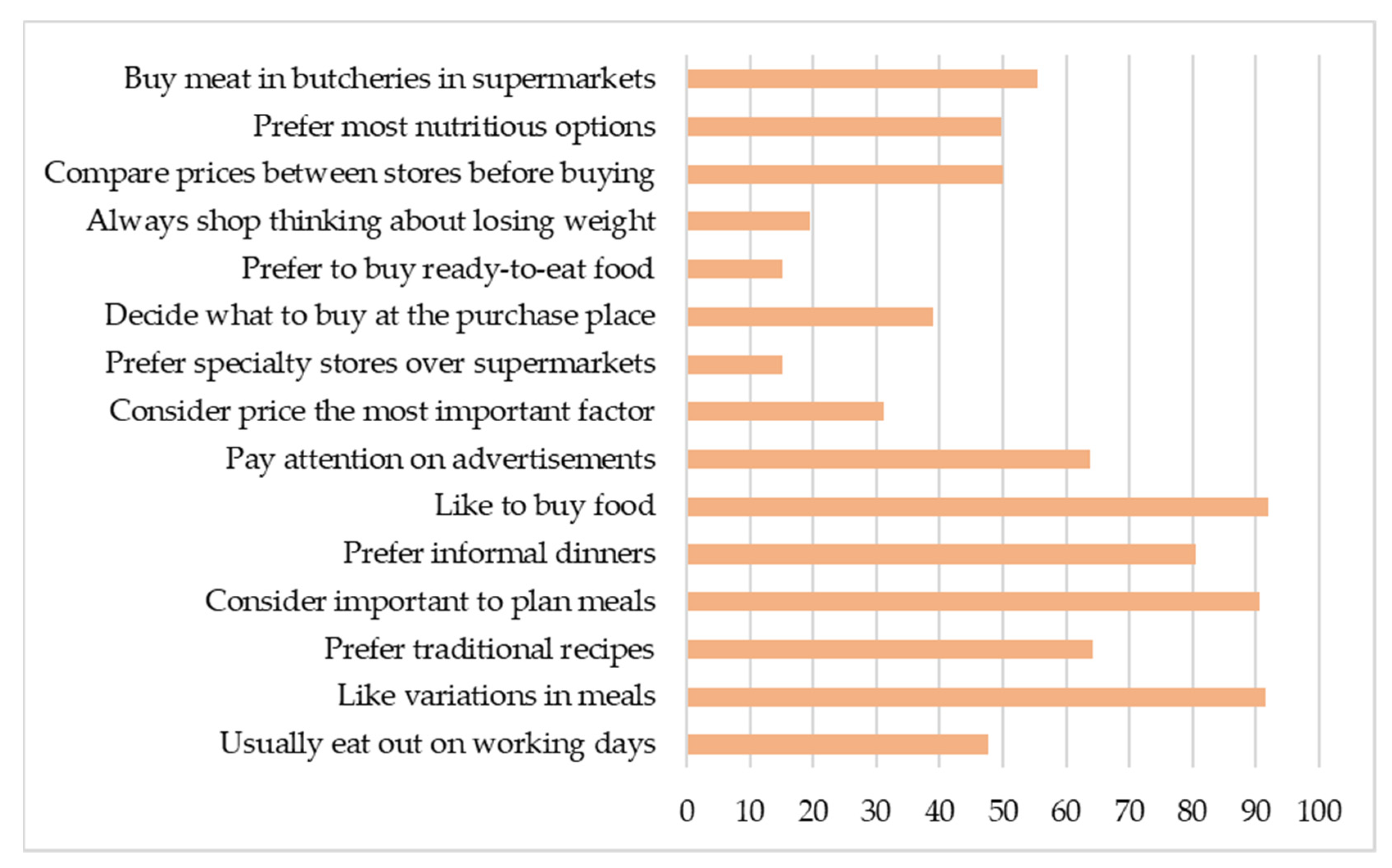
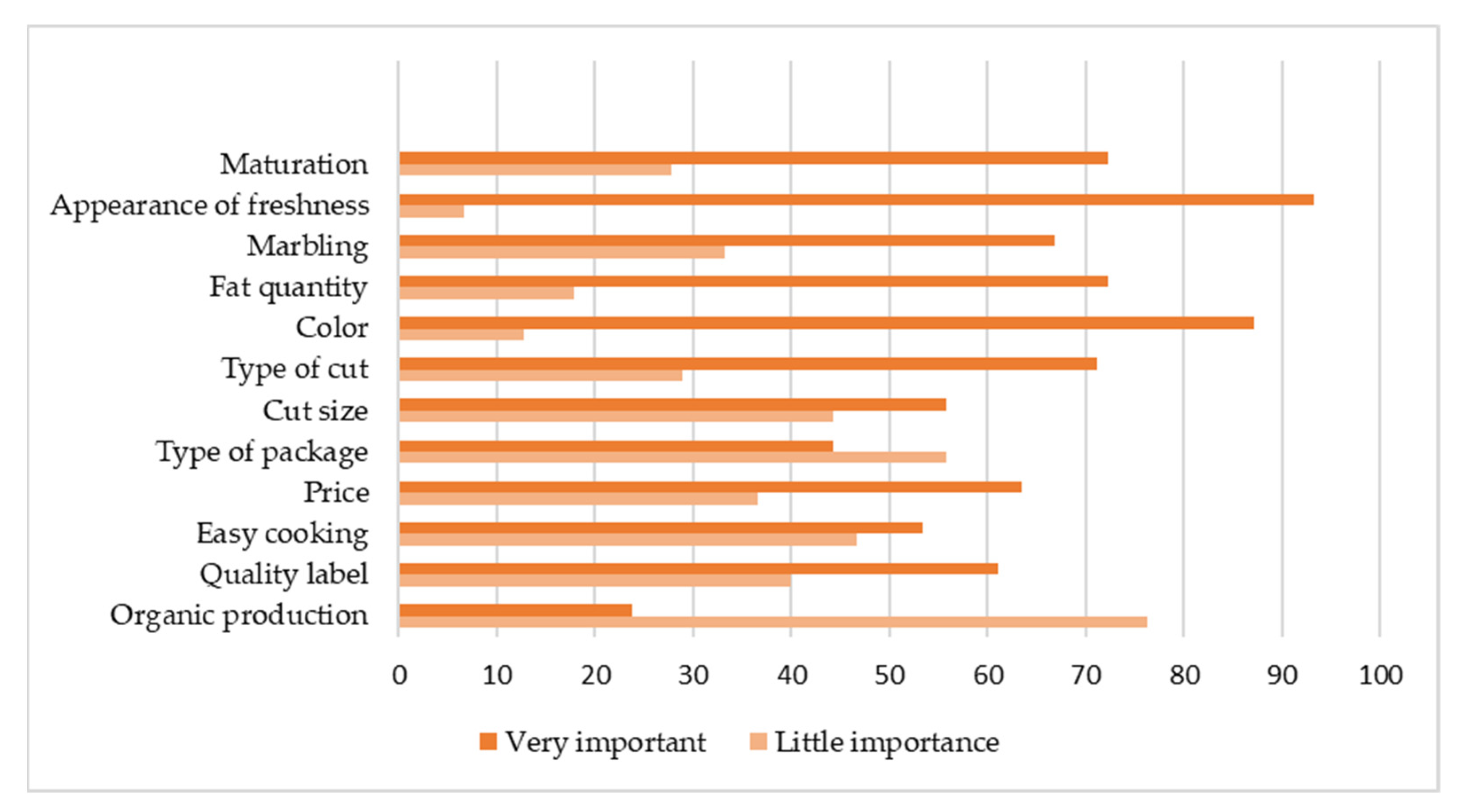
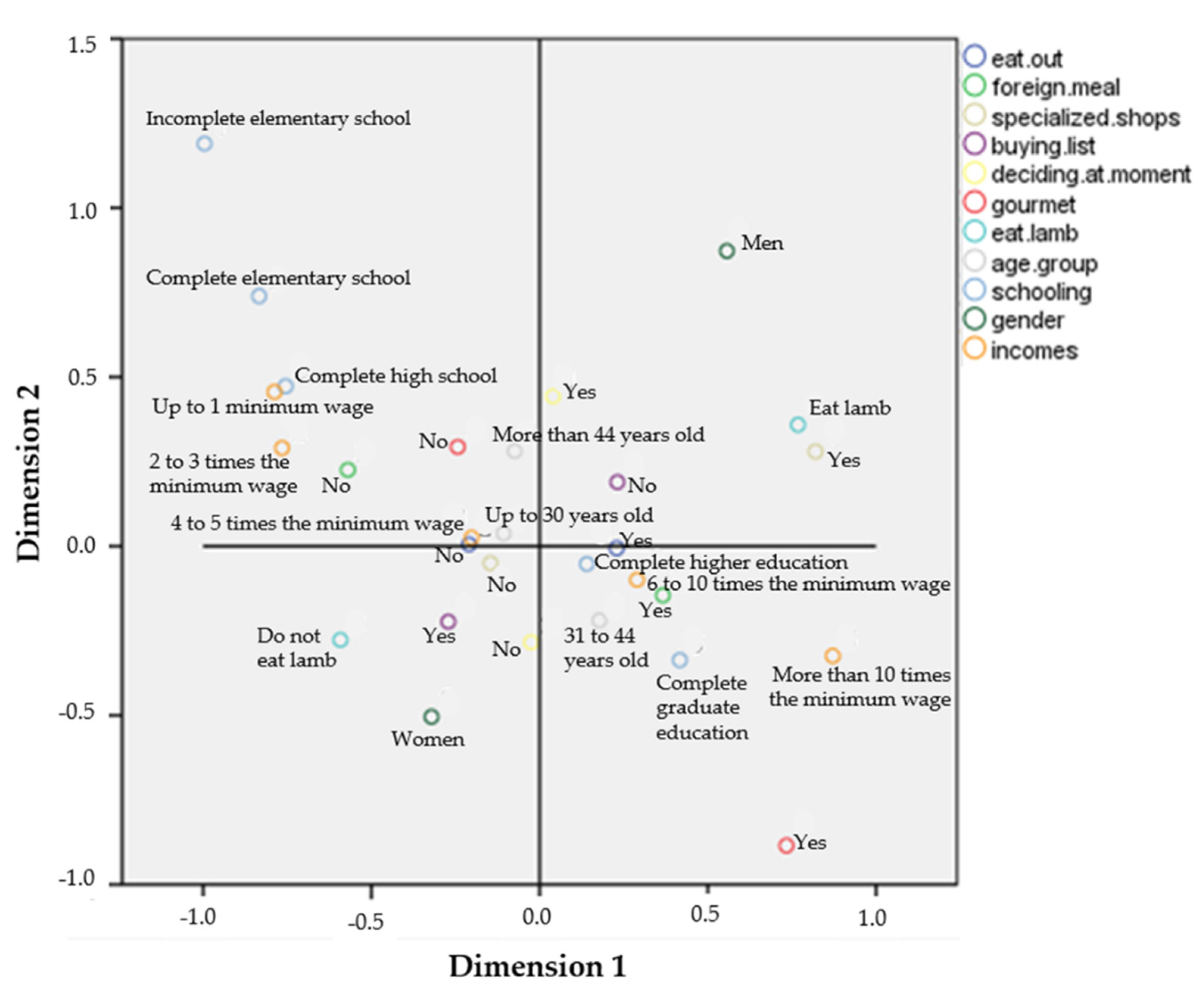
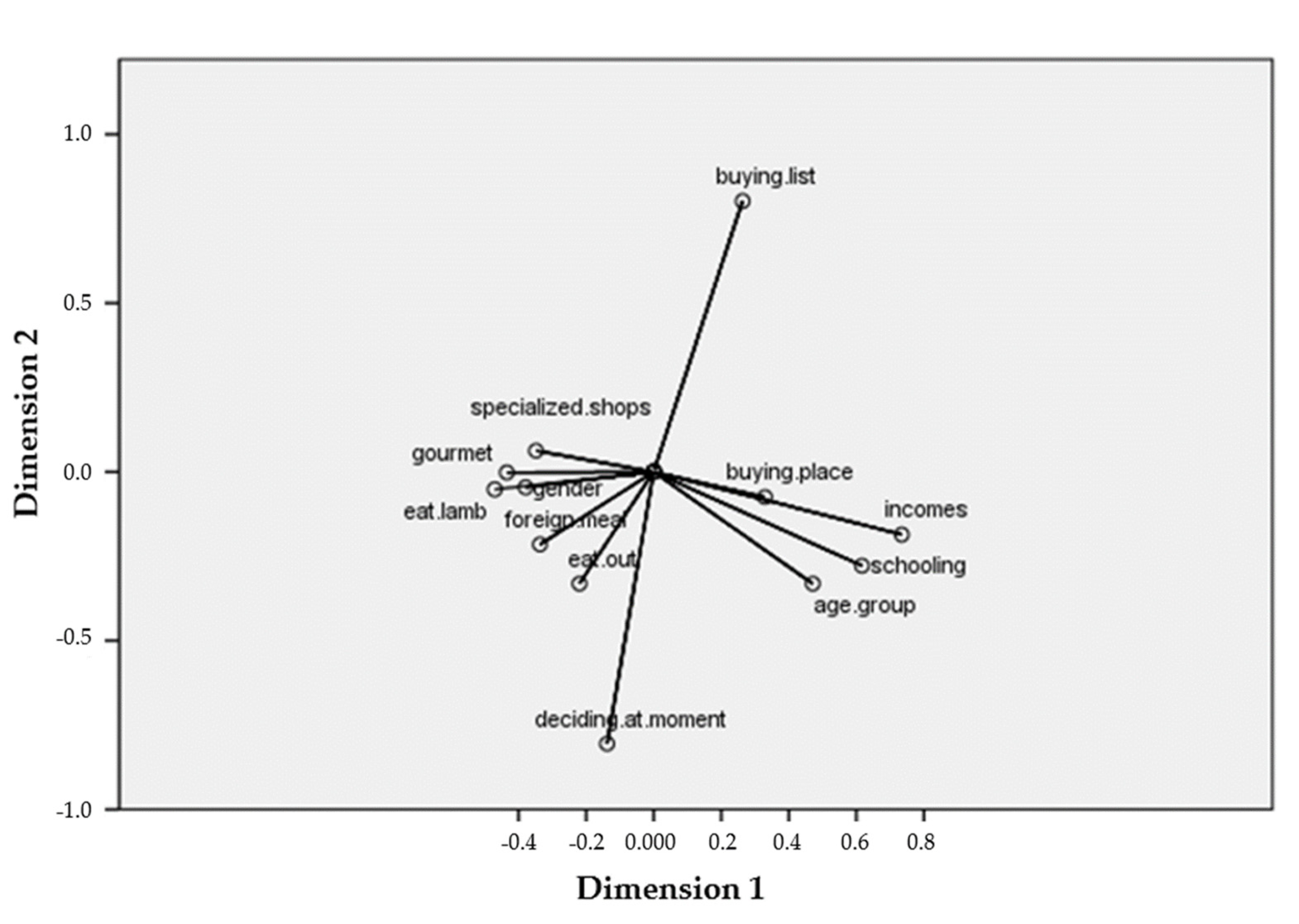
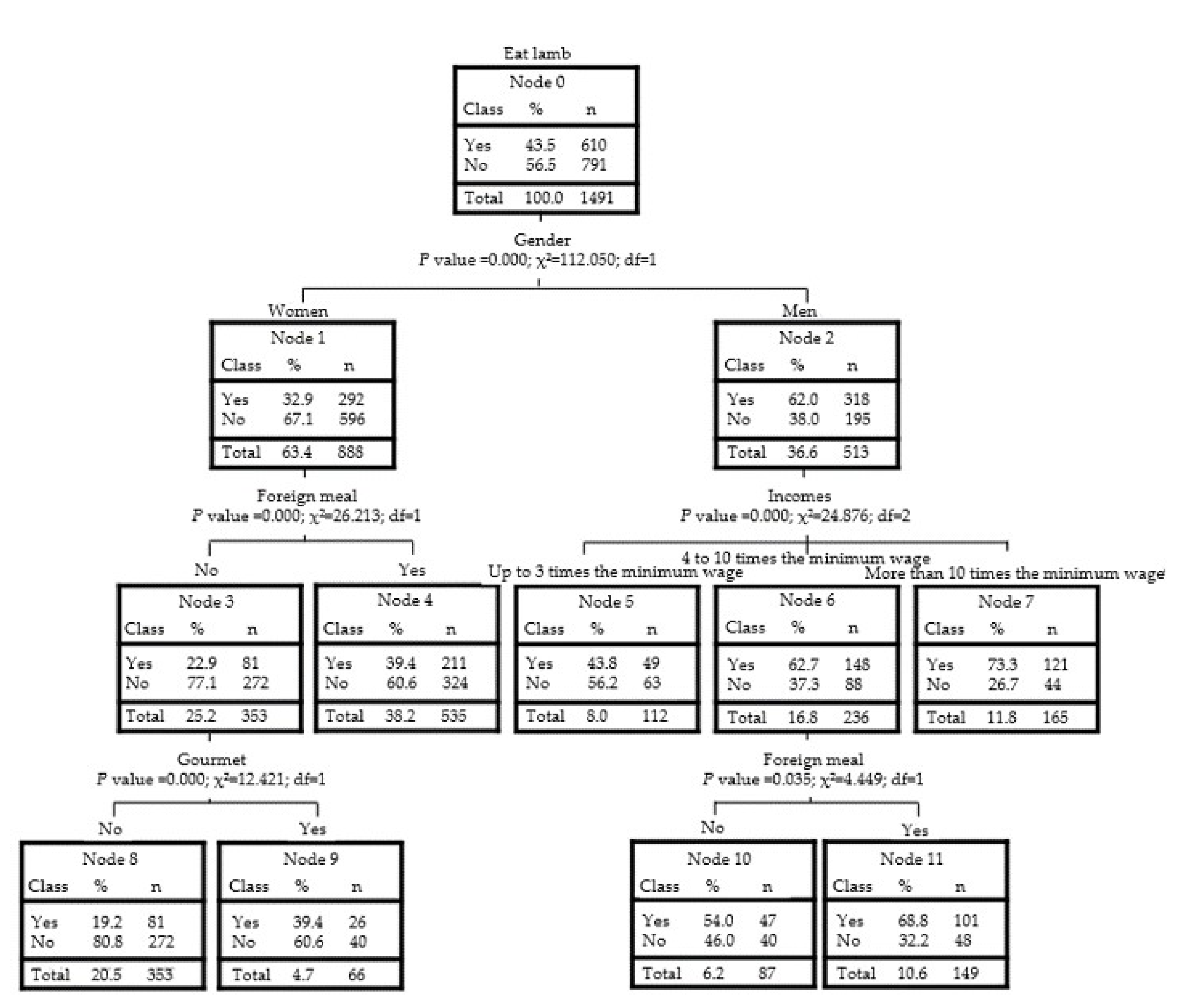

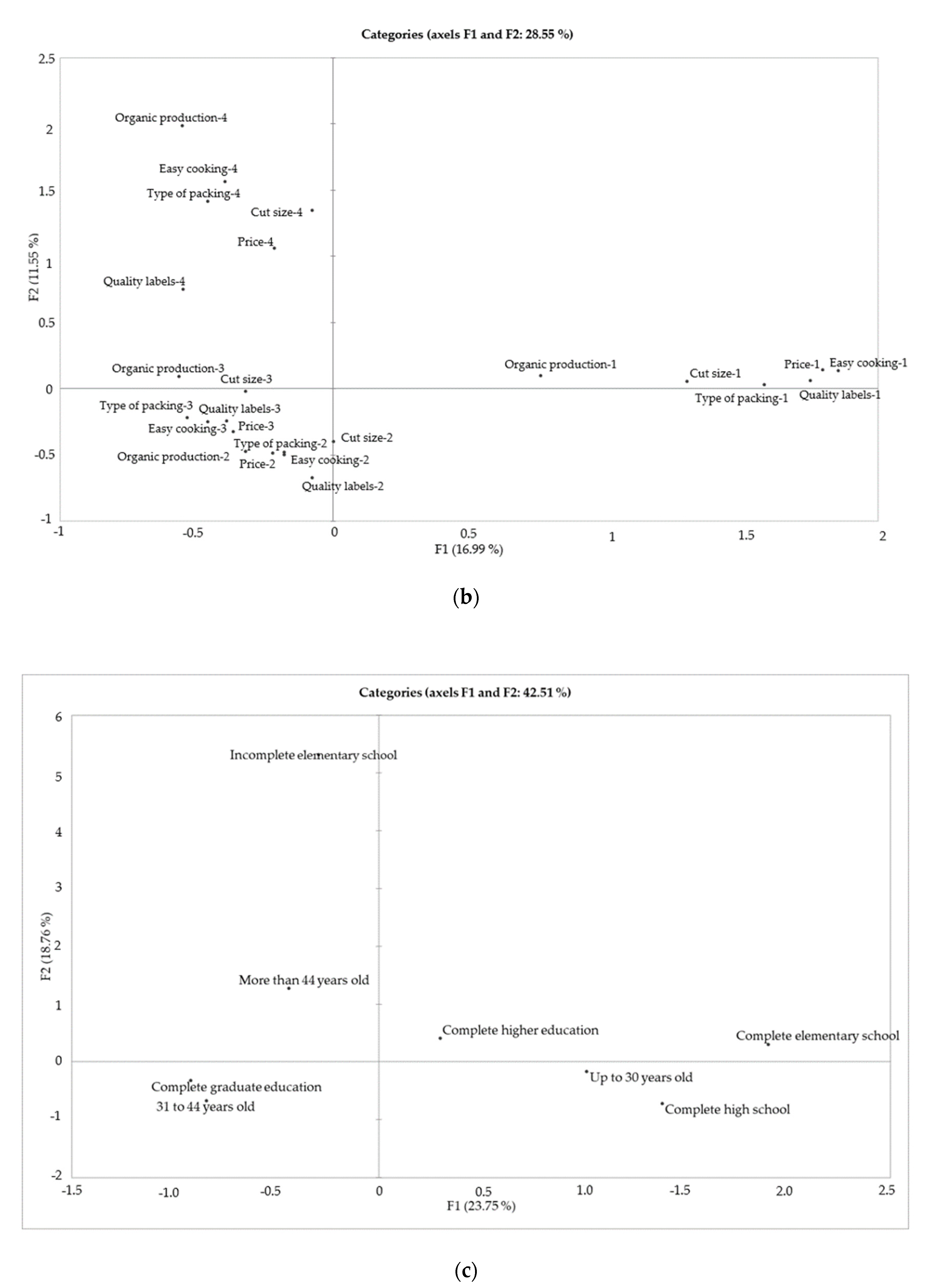
| (A) Food Preparation and Consumption Habits | ||||||||
|---|---|---|---|---|---|---|---|---|
| We would like to know your food preparation and consumption habits. Please, mark true or false. | ||||||||
| Habit | True | False | ||||||
| I like to cook | ||||||||
| I usually eat out on working days | ||||||||
| I like foreign food | ||||||||
| I like variations in my meals | ||||||||
| In my home, everyone cooks | ||||||||
| Traditional recipes are better | ||||||||
| I spend a lot of time cooking | ||||||||
| Planning meals is important for family health | ||||||||
| I like to celebrate with friends and family | ||||||||
| My family prefers informal dinners | ||||||||
| I only eat in restaurants | ||||||||
| I eat lamb meat | ||||||||
| (B) Food Buying Habits | ||||||||
| We would like to know your food buying habits. Please, mark true or false. | ||||||||
| Habit | True | False | ||||||
| I like to buy food | ||||||||
| I pay attention to advertisements | ||||||||
| Reading labels is very important to me | ||||||||
| Price is the most important thing for me | ||||||||
| I prefer specialty stores over supermarkets | ||||||||
| I always follow a shopping list | ||||||||
| I decide what to buy when I arrive at the place of purchase | ||||||||
| I usually try everything that is trendy | ||||||||
| I prefer to buy ready-to-eat food | ||||||||
| I always shop thinking about losing weight | ||||||||
| I compare prices between stores/supermarkets before buying | ||||||||
| I always choose the most nutritious options | ||||||||
| I usually buy gourmet options | ||||||||
| I always opt for organic versions | ||||||||
| (C) Meat Buying Habits | ||||||||
| Where do you buy meat most often? ( ) Directly from the producer ( ) Traditional butcheries ( ) Butcheries in supermarkets ( ) Packaged (in supermarkets) ( ) Others | ||||||||
| How often do you eat lamb meat? ( ) 1 time or more per week ( ) 2 to 3 times per month ( ) 1 time per month ( ) Less than 1 time per month ( ) Never | ||||||||
| (D) Importance of Attributes Intrinsic and Extrinsic to Lamb Meat at the Time of Purchase 1 | ||||||||
| How important do you consider the following extrinsic quality criteria of lamb meat? | ||||||||
| Attribute | Very little important | Little important | Important | Very important | ||||
| Organic production | ||||||||
| Quality labels | ||||||||
| Easy-cooking | ||||||||
| Price | ||||||||
| Type of packing | ||||||||
| How important do you consider the following intrinsic quality criteria of lamb meat? | ||||||||
| Attribute | Very little important | Little important | Important | Very important | ||||
| Type of cut | ||||||||
| Cut size | ||||||||
| Color | ||||||||
| Fat quantity | ||||||||
| Marbling | ||||||||
| Appearance of freshness | ||||||||
| Maturation | ||||||||
| (E) Reason for not Eating Lamb Meat 2 | ||||||||
| Why do you not eat lamb meat? ( ) I do not like lamb meat ( ) I never tasted lamb meat ( ) My family does not like lamb meat ( ) Lamb meat is expensive ( ) Lamb meat is hard to find to buy ( ) I do not know how to prepare lamb meat ( ) It is hard to prepare lamb meat ( ) Other (please specify) ____________________ | ||||||||
| (F) Sociodemographic Characterization | ||||||||
| Now, some data about you. | ||||||||
| Age ( ) Up to 30 years old ( ) 31–44 years old ( ) 45 years old or more | ||||||||
| Gender ( ) Female ( ) Male | ||||||||
| Schooling ( ) Incomplete elementary school ( ) Complete elementary school ( ) Complete high school ( ) Complete higher education ( ) Complete graduate education | ||||||||
| State of origin (Specify the state among the 26 Brazilian states) | ||||||||
| Family income 3 ( ) Up to 1 minimum wage ( ) 2 to 3 times the minimum wage ( ) 4 to 5 times the minimum wage ( ) 6 to 10 times the minimum wage ( ) More than 10 times the minimum wage | ||||||||
| Place of residence ( ) Rural ( ) Urban | ||||||||
| Age | ||
|---|---|---|
| National average | Sample | |
| Up to 30 years old | 42.3 | 43.3 |
| 31 to 44 years old | 22.3 | 35.1 |
| 45 years old or more | 35.4 | 21.6 |
| Gender | ||
| National average | Sample | |
| Female | 51.8 | 63.4 |
| Male | 48.2 | 36.6 |
| Place of Residence | ||
| National average | Sample | |
| Rural | 15.3 | 4.7 |
| Urban | 84.7 | 95.3 |
| Schooling 1 | ||
| National average | Sample | |
| Incomplete elementary school | 38.6 | 1.3 |
| Complete elementary school | 12.5 | 1.7 |
| Complete high school | 31.8 | 22.6 |
| Complete higher or graduate education | 17.4 | 74.5 |
Publisher’s Note: MDPI stays neutral with regard to jurisdictional claims in published maps and institutional affiliations. |
© 2021 by the authors. Licensee MDPI, Basel, Switzerland. This article is an open access article distributed under the terms and conditions of the Creative Commons Attribution (CC BY) license (https://creativecommons.org/licenses/by/4.0/).
Share and Cite
Battagin, H.V.; Panea, B.; Trindade, M.A. Study on the Lamb Meat Consumer Behavior in Brazil. Foods 2021, 10, 1713. https://doi.org/10.3390/foods10081713
Battagin HV, Panea B, Trindade MA. Study on the Lamb Meat Consumer Behavior in Brazil. Foods. 2021; 10(8):1713. https://doi.org/10.3390/foods10081713
Chicago/Turabian StyleBattagin, Heloísa Valarine, Begoña Panea, and Marco Antonio Trindade. 2021. "Study on the Lamb Meat Consumer Behavior in Brazil" Foods 10, no. 8: 1713. https://doi.org/10.3390/foods10081713
APA StyleBattagin, H. V., Panea, B., & Trindade, M. A. (2021). Study on the Lamb Meat Consumer Behavior in Brazil. Foods, 10(8), 1713. https://doi.org/10.3390/foods10081713







